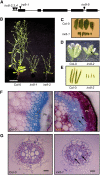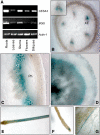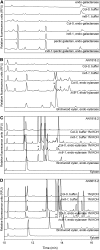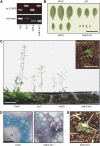The Arabidopsis irregular xylem8 mutant is deficient in glucuronoxylan and homogalacturonan, which are essential for secondary cell wall integrity
- PMID: 17237350
- PMCID: PMC1820957
- DOI: 10.1105/tpc.106.047720
The Arabidopsis irregular xylem8 mutant is deficient in glucuronoxylan and homogalacturonan, which are essential for secondary cell wall integrity
Abstract
The secondary cell wall in higher plants consists mainly of cellulose, lignin, and xylan and is the major component of biomass in many species. The Arabidopsis thaliana irregular xylem8 (irx8) mutant is dwarfed and has a significant reduction in secondary cell wall thickness. IRX8 belongs to a subgroup of glycosyltransferase family 8 called the GAUT1-related gene family, whose members include GAUT1, a homogalacturonan galacturonosyltransferase, and GAUT12 (IRX8). Here, we use comparative cell wall analyses to show that the irx8 mutant contains significantly reduced levels of xylan and homogalacturonan. Immunohistochemical analyses confirmed that the level of xylan was significantly reduced in the mutant. Structural fingerprinting of the cell wall polymers further revealed that irx8 is deficient in glucuronoxylan. To explore the biological function of IRX8, we crossed irx8 with irx1 (affecting cellulose synthase 8). The homozygous irx1 irx8 exhibited severely dwarfed phenotypes, suggesting that IRX8 is essential for cell wall integrity during cellulose deficiency. Taken together, the data presented show that IRX8 affects the level of glucuronoxylan and homogalacturonan in higher plants and that IRX8 provides an important link between the xylan polymer and the secondary cell wall matrix and directly affects secondary cell wall integrity.
Figures










Similar articles
-
Arabidopsis irregular xylem8 and irregular xylem9: implications for the complexity of glucuronoxylan biosynthesis.Plant Cell. 2007 Feb;19(2):549-63. doi: 10.1105/tpc.106.049320. Epub 2007 Feb 23. Plant Cell. 2007. PMID: 17322407 Free PMC article.
-
Highly Branched Xylan Made by IRREGULAR XYLEM14 and MUCILAGE-RELATED21 Links Mucilage to Arabidopsis Seeds.Plant Physiol. 2015 Dec;169(4):2481-95. doi: 10.1104/pp.15.01441. Epub 2015 Oct 19. Plant Physiol. 2015. PMID: 26482889 Free PMC article.
-
A review of xylan and lignin biosynthesis: foundation for studying Arabidopsis irregular xylem mutants with pleiotropic phenotypes.Crit Rev Biochem Mol Biol. 2014 May-Jun;49(3):212-41. doi: 10.3109/10409238.2014.889651. Epub 2014 Feb 24. Crit Rev Biochem Mol Biol. 2014. PMID: 24564339 Review.
-
The irregular xylem9 mutant is deficient in xylan xylosyltransferase activity.Plant Cell Physiol. 2007 Nov;48(11):1624-34. doi: 10.1093/pcp/pcm135. Epub 2007 Oct 15. Plant Cell Physiol. 2007. PMID: 17938130
-
Biosynthesis and properties of the plant cell wall.Curr Opin Plant Biol. 2002 Dec;5(6):536-42. doi: 10.1016/s1369-5266(02)00306-0. Curr Opin Plant Biol. 2002. PMID: 12393017 Review.
Cited by
-
Current challenges in cell wall biology in the cereals and grasses.Front Plant Sci. 2012 Jun 15;3:130. doi: 10.3389/fpls.2012.00130. eCollection 2012. Front Plant Sci. 2012. PMID: 22715340 Free PMC article.
-
Loss of function of cinnamyl alcohol dehydrogenase 1 leads to unconventional lignin and a temperature-sensitive growth defect in Medicago truncatula.Proc Natl Acad Sci U S A. 2013 Aug 13;110(33):13660-5. doi: 10.1073/pnas.1312234110. Epub 2013 Jul 30. Proc Natl Acad Sci U S A. 2013. PMID: 23901113 Free PMC article.
-
Oryza sativa PECTIN DEFECTIVE TAPETUM1 affects anther development through a pectin-mediated signaling pathway in rice.Plant Physiol. 2022 Jun 27;189(3):1570-1586. doi: 10.1093/plphys/kiac172. Plant Physiol. 2022. PMID: 35511278 Free PMC article.
-
The Evolution and Functional Roles of miR408 and Its Targets in Plants.Int J Mol Sci. 2022 Jan 4;23(1):530. doi: 10.3390/ijms23010530. Int J Mol Sci. 2022. PMID: 35008962 Free PMC article. Review.
-
Genome-Wide Study of the GATL Gene Family in Gossypium hirsutum L. Reveals that GhGATL Genes Act on Pectin Synthesis to Regulate Plant Growth and Fiber Elongation.Genes (Basel). 2020 Jan 6;11(1):64. doi: 10.3390/genes11010064. Genes (Basel). 2020. PMID: 31935825 Free PMC article.
References
-
- Alonso, J., et al. (2003). Genome-wide insertional mutagenesis of Arabidopsis thaliana. Science 301 653–657. - PubMed
-
- Awano, T., Takabe, K., and Fujita, M. (2002). Xylan deposition on secondary wall of Fagus crenata fiber. Protoplasma 219 106–115. - PubMed
-
- Bauer, S., Vasu, P., Mort, A.J., and Somerville, C.R. (2005). Cloning, expression, and characterization of an oligoxyloglucan reducing end-specific xyloglucanobiohydrolase from Aspergillus nidulans. Carbohydr. Res. 340 2590–2597. - PubMed
Publication types
MeSH terms
Substances
LinkOut - more resources
Full Text Sources
Other Literature Sources
Molecular Biology Databases

